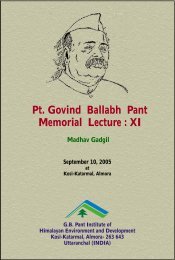Pandit Govind Ballabh Pant Memorial Lecture: II
Pandit Govind Ballabh Pant Memorial Lecture: II
Pandit Govind Ballabh Pant Memorial Lecture: II
You also want an ePaper? Increase the reach of your titles
YUMPU automatically turns print PDFs into web optimized ePapers that Google loves.
existence, other are proposed. Their management has to be on scientific and<br />
technological lines so as to ensure in perpetuity the conservation of the biotic wealth<br />
found in these areas. Rodgers and Panwar (1988) have given a detailed account of<br />
such areas, their data, summarized in Table 3, deal with Trans-Himalayan Ladakh,<br />
North-West Himalaya, West Himalaya, Central Himalaya, Eastern Himalaya, Upper<br />
Gangetic Plains, Brahmaputra Valley and Assam Hills. This area is 63,318sq. Km<br />
which includes both existing (E) and proposed (P) conservation areas. Thus about<br />
8.5% of Himalaya is under conservation (Table 3).<br />
Three Himalayan States are among the best covered states of India as far as<br />
protected areas are concerned. These are Sikkim (965 sq. km.=13.2%), Himachal<br />
Pradesh (3918 sq. km.=7.0%) and Arunachal Pradesh (14895 sq. km.=4.%). The<br />
three states with no protected areas are Mizoram, Nagaland and Tripura. .pa<br />
Table 3: Existing and proposed areas under conservation in Himalaya<br />
Biome Total Area Existing (E) and Proposed Per cent<br />
Sq. Km. (P) Area under conservation<br />
(Sq.Km.)<br />
Ladakh 1,86,200 E 800<br />
P 12,010<br />
North-West 69,000 E 4,025 4.5<br />
Himalaya P 4,849 5.4<br />
West Himalaya 72,000 E 3,885 5.3<br />
P 5,105 7.1<br />
Central Himalaya 12,300 E 1,234 10.0<br />
P 2,338 19.0<br />
East Himalaya 83,000 E 3,764 4.5<br />
P 11,187 13.5<br />
Upper Gangtic Plains 2,06,400 E 3,348 1.6<br />
Plains P 4,512 2.2<br />
Bhahmaputra Valley 65,200 E 1,280 2.0<br />
P 4,030 6.2<br />
Assam Hills 1,06,200 E 602 0.5<br />
P 5,351 5.0<br />
Total 800,300 68,318 8.5<br />
Source: Rodgers and Panwar, 1988<br />
Out of the 14 biosphere reserves proposed, six falls in the Himalayan belt. These<br />
are: Nada Devi (2600sq. km.), Uttarakhand (also known as Valley of Flowers 3941 sq.<br />
km.), Manas (2837 sq. km.), Namdapha (7000sq. km.), Nokrek (60sq. km.) and<br />
Kaziranga (37823 sq. km.). Over the years fairly detailed documents have been<br />
29











